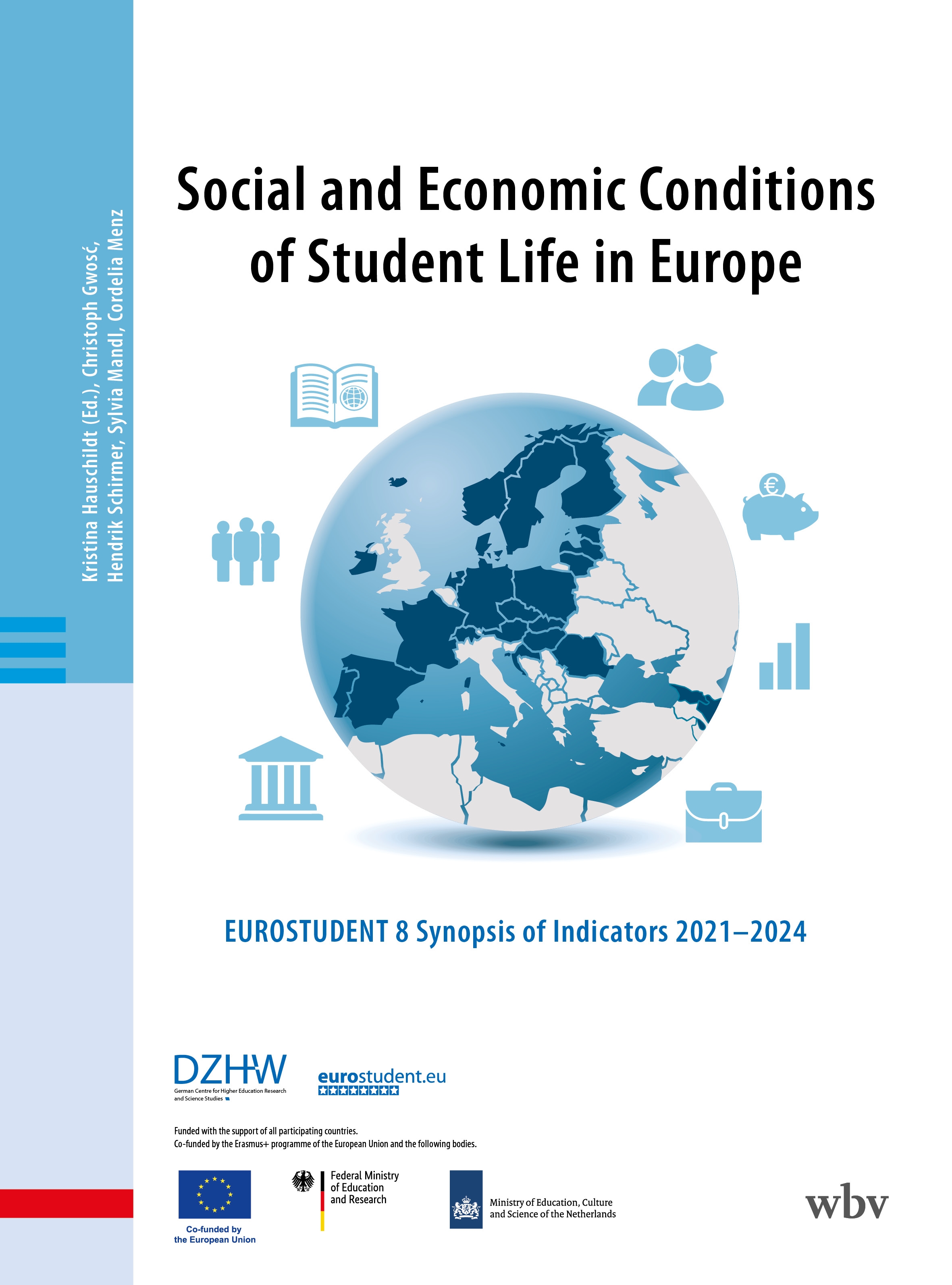Social and Economic Conditions of Student Life in Europe
Eurostudent 8 Synopsis of Indicators 2021-2024
Die EUROSTUDENT 8 ist die zentrale Veröffentlichung des EUROSTUDENT-Projekts und das Ergebnis der Zusammenarbeit eines europaweiten Netzwerks aus Forschern, Datenerhebern, Vertretern nationaler Ministerien und anderen Beteiligten. Sie enthält Daten aus Studierendenbefragungen, die in 25 Ländern des Europäischen Hochschulraums während der achten Runde des EUROSTUDENT-Projekts durchgeführt wurden. Die Publikation nimmt eine breite, vergleichende Perspektive ein und liefert Informationen über den sozioökonomischen und studienbezogenen Hintergrund der Studierenden, ihre Studienbedingungen und -erfahrungen, einschließlich internationaler Mobilität, sowie ihre Lebensbedingungen. Sie soll politische Debatten zum Thema der sozialen Dimension anregen und die Grundlage für weitere Forschung schaffen.
A1 Foreword
A2 Introduction
A3 General methodological notes
B Empirical findings and interpretation
B1 Characteristics of national student populations
B2 Socio-economic background of students
B3 Transition into and within higher education
B4 Types and modes of study
B5 Students' time budget
B6 Students' employment and internships
B7 Students' resources
B8 Students' expenses
B9 Students' housing situation
B10 International student mobility
B11 Policy considerations
C Appendix
C1 Glossary
C2 Methodological notes on figures and tables
C3 Metadata
C4 National contributors
Kristina Hauschildt, Christoph Gwosć, Hendrik Schirmer, Sylvia Mandl und Cordelia Menz sind Forscher:innen des Projekts EUROSTUDENT und arbeiten am deutschen Zentrum für Hochschul- und Wissenschaftsforschung (DZHW) bzw. am Institut für Höhere Studien (IHS), Wien. Sie forschen und arbeiten zur Lebens- und Studiensituation von Studierenden, mit einem Schwerpunkt auf der sozialen Dimension des Studiums.
Beiträge
weitere Infos
- EUROSTUDENT 8: Daten zu Hochschulzugängen, Finanzierung und Mobilität von Studierenden in Europa -
Datenanalysen zum europäischen Hochschulraum 2021 - 2024
Studieren in Europa ist so vielfältig, wie die fast 300 Millionen Studentinnen und Studenten in den über 40 Ländern des Europäischen Hochschulraums (EHEA). Das betrifft Studienvoraussetzungen und Zugangsmöglichkeiten ebenso, wie den Studierendenalltag. Wo die Unterschiede liegen und welche Gemeinsamkeiten Studium und studentisches Leben in den verschiedenen europäischen Ländern aufweisen, wird seit über 20 Jahren im Projekt EUROSTUDENT untersucht. Die differenzierten Analysen von Daten, die bei über 290.000 Studierenden erhoben werden, bilden die Vielfalt der Studienerfahrungen ab und ermöglichen gezielte Entwicklungen von Maßnahmen, die Chancengleichheit und Erfolg im Hochschulbereich fördern. Mit »Social and Economic Conditions of Student Life in Europe - EUROSTUDENT 8 Synopsis of Indicators 2021 - 2024« liegt jetzt der aktuelle Projektbericht vor.
- Zentrale Ergebnisse -
Für die meisten Studierenden ist das Studium ein Fulltime-Job. Sie investieren durchschnittlich 48 Stunden pro Woche in Studium und studienrelevante Aktivitäten. Studierende aus bildungsfernerem oder finanziell schlechter gestelltem Elternhaus sind in beinahe allen Ländern unterrepräsentiert. Sie finanzieren ihr Studium oft durch eigenes Einkommen oder öffentliche Unterstützung, studieren häufiger in Teilzeit und wählen öfter nicht-universitäre Einrichtungen und short-cycle Studiengänge. Alternative Zugangswege ermöglichen es einer breiteren und vielfältigeren Gruppe von Menschen, eine Hochschulbildung zu verfolgen und erhöhen die Altersdiversität. Jede/r vierte Studierende (24 %) in den EUROSTUDENT-Ländern hat einen internationalen Hintergrund durch Familie oder Bildungsbiografie. 14 % der Studierenden wurden im Ausland geboren oder haben mindestens einen im Ausland geborenen Elternteil. Im Durchschnitt arbeiten 59 % der Studierenden im Erhebungsraum während des Studiums, jede/r fünfte Studierende sieht sich eher als Arbeitnehmer:in denn als Student:in.
- Daten -
Die Daten, die für »Social and Economic Conditions of Student Life in Europe - EUROSTUDENT 8 Synopsis of Indicators 2021 - 2024« ausgewertet wurden, bilden alle wichtigen Themen der Studien- und Lebenssituation Studierender ab, vom Hochschulzugang über die aktuelle Studiensituation bis zu Erwerbstätigkeit, Studienfinanzierung, Wohnsituation und studienbezogener Auslandsmobilität. Befragt wurden Studierende aus allen Regionen Europas, von Island bis Malta und von Portugal bis Aserbaidschan. Daten aus den EUROSTUDENT-Runden 7 und 8 sind beim Forschungsdatenzentrum (FDZ) des Deutschen Zentrums für Hochschul- und Wissenschaftsforschung (DZHW) als Scientific Use Files verfügbar.
- Projekt EUROSTUDENT -
Der Bericht ist die wichtigste Publikation des internationalen Projekts EU-ROSTUDENT und erscheint ausschließlich in englischer Sprache. Das Projekt wird von einem internationalen Konsortium aus sechs Organisationen getragen und von einem Netzwerk aus Forscher:innen und Vertreter:innen nationaler Ministerien sowie weiteren Stakeholdern aus ganz Europa umgesetzt. Aus den gesammelten Daten erstellt EUROSTUDENT umfassende Studien zu sozialen und wirtschaftlichen Bedingungen des Studierendenlebens, zur sozialen Dimension in den EHEA-Ländern sowie zu Faktoren wie Bildungs- und Wirtschaftssystemen, politischen Rahmenbedingungen und kulturellen Normen, die das Studium beeinflussen. EUROSTUDENT 8 wurde von allen beteiligten Ländern finanziert und vom Erasmus+-Programm der Europäischen Union (EU), dem deutschen Bundesministerium für Bildung und Forschung (BMBF) sowie dem niederländischen Ministerium für Bildung, Kultur und Wissenschaft (MinOCW) gefördert.
- Autor:innen/Herausgeberin -
Kristina Hauschildt, Christoph Gwosć, Hendrik Schirmer, Sylvia Mandl, Cordelia Menz sind Forscher:innen des Projekts EUROSTUDENT und arbeiten am deutschen Zentrum für Hochschul- und Wissenschaftsforschung (DZHW) bzw. am Institut für Höhere Studien (IHS), Wien. Sie forschen und arbeiten zur Lebens- und Studiensituation von Studierenden, mit einem Schwerpunkt auf der sozialen Dimension des Studiums.
--------------------------
Kristina Hauschildt (Hrsg.), Christoph Gwosć, Hendrik Schirmer, Sylvia Mandl, Cordelia Menz
- Social and Economic Conditions of Student Life in Europe - Eurostudent 8 Synopsis of Indicators 2021-2024
320 Seiten, Bielefeld 2024, 49,90 Euro
Artikel-Nr. 6001920e
ISBN 978-3-7639-7746-8
DOI 10.3278/6001920ew
digitale Ausgabe kostenfrei bei wbv-open-access.de
